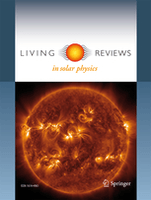
Living Reviews in Solar Physics
Scope & Guideline
Transforming Solar Research through Open Access
Introduction
Aims and Scopes
- Solar Activity and Dynamics:
Focuses on the mechanisms driving solar activity, including solar flares, solar wind, and magnetic reconnection, offering insights into the dynamics of the Sun's atmosphere and interior. - Historical and Long-term Solar Studies:
Explores the historical context of solar activity and its variations over millennia, helping to contextualize current solar phenomena within a long-term framework. - Solar Structure and Magnetic Fields:
Investigates the structure of the Sun, including its magnetic fields and meridional circulation, providing a foundational understanding of solar dynamics. - Impact of Solar Phenomena on Space Weather:
Discusses the implications of solar activity for space weather, emphasizing the importance of understanding solar processes for predicting and mitigating space weather effects on Earth. - Advancements in Observation and Modeling:
Highlights the latest advancements in observational techniques and modeling approaches, including the use of machine learning, to enhance the understanding of solar physics.
Trending and Emerging
- Machine Learning Applications:
The increasing application of machine learning techniques in solar physics is a notable trend, as researchers seek to analyze complex data sets and enhance predictive models for solar activity. - Next-Generation Observational Techniques:
There is a notable emphasis on next-generation solar telescopes and their capabilities, highlighting the importance of advanced observational tools in understanding solar waves and atmospheric dynamics. - Extreme Solar Events:
The focus on extreme solar events and their implications for space weather is gaining traction, underscoring the need for better prediction and understanding of these potentially disruptive phenomena. - Long-term Solar Studies:
A growing interest in the long-term variations of solar activity and historical analysis reflects an emerging recognition of the importance of historical context in current solar research.
Declining or Waning
- Traditional Theoretical Models:
There appears to be a waning emphasis on traditional theoretical models of solar phenomena, as newer methodologies and observational techniques are gaining prominence. - Surface Phenomena without Contextualization:
Research focusing solely on surface phenomena without integrating broader solar dynamics or historical context seems to be declining, indicating a shift towards more holistic approaches.
Similar Journals

Kinematics and Physics of Celestial Bodies
Pioneering Research in Celestial DynamicsKinematics and Physics of Celestial Bodies is a prominent journal published by PLEIADES PUBLISHING INC, dedicated to the exploration and understanding of celestial mechanics and the physical properties of astronomical bodies. With an ISSN of 0884-5913 and an E-ISSN of 1934-8401, this journal has established itself as a resource for researchers in the fields of astronomy, astrophysics, and space science since its inception in 2009. The journal is indexed in Scopus, where it currently ranks in the fourth quartile for both Astronomy and Astrophysics and Space and Planetary Science, making it a valuable platform for scholarly discourse despite its ranking. Its scope encompasses a range of topics related to the kinematics and physical characteristics of celestial objects, aiming to facilitate a better understanding of their dynamics and interactions within the universe. Although it does not operate under an open access model, the journal provides essential insights and findings, catering to the academic needs of researchers, professionals, and students engaged in the study of the cosmos. The journal's commitment to advancing knowledge in the various aspects of celestial physics ultimately contributes to the broader scientific community's endeavors.
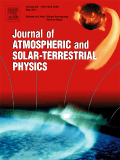
JOURNAL OF ATMOSPHERIC AND SOLAR-TERRESTRIAL PHYSICS
Fostering Interdisciplinary Dialogue in Atmospheric ScienceJournal of Atmospheric and Solar-Terrestrial Physics, published by Pergamon-Elsevier Science Ltd, stands as a pivotal academic resource in the realms of Atmospheric Science, Geophysics, and Space and Planetary Science. With an ISSN of 1364-6826 and an E-ISSN of 1879-1824, this journal encompasses a robust collection of research findings and reviews that address the intricacies of atmospheric processes and solar-terrestrial interactions. The journal has shown consistent academic performance, earning commendable rankings in 2023, including Q3 in Atmospheric Science and Q2 in Geophysics, reflecting its importance for scholarly communication and advancement in these fields. Spanning an impressive convergence of research from 1997 to 2024, it aims to foster interdisciplinary collaboration and inspire innovations among researchers, professionals, and students. Although it currently does not offer open access, the journal is committed to disseminating high-quality content that continues to drive forward our understanding of complex environmental phenomena.
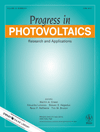
PROGRESS IN PHOTOVOLTAICS
Transforming Sunlight into Sustainable SolutionsPROGRESS IN PHOTOVOLTAICS, published by Wiley, is a leading scholarly journal dedicated to the advancement of photovoltaic technology and its applications. Since its inception in 1993, this journal has maintained a strong focus on the latest developments in solar energy, addressing both theoretical and practical aspects of photovoltaic systems. With an impressive impact factor and consistently ranked in the Q1 quartile across four key categories—Condensed Matter Physics, Electrical and Electronic Engineering, Electronic, Optical and Magnetic Materials, and Renewable Energy, Sustainability, and the Environment—PROGRESS IN PHOTOVOLTAICS is regarded as a pillar of scholarly excellence. The journal is essential for researchers, professionals, and students who seek to stay at the forefront of innovations and sustainability in the energy sector. Although it does not primarily offer open access, its commitment to advancing the understanding of photovoltaic technologies ensures that readers can expect high-quality, peer-reviewed research that pushes the boundaries of current knowledge.
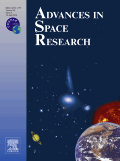
ADVANCES IN SPACE RESEARCH
Elevating Knowledge Beyond Earth.ADVANCES IN SPACE RESEARCH, published by Elsevier Science Ltd, is a leading journal in the fields of Aerospace Engineering, Astronomy and Astrophysics, Atmospheric Science, and more. Since its inception in 1981, this journal has dedicated itself to the dissemination of high-quality research contributing to the understanding of space and planetary sciences through a multidisciplinary lens. With an impressive impact factor reflected in its positioning within the Q1 and Q2 quartiles across various categories, it serves as an essential resource for researchers and professionals alike. The journal's rigorous peer review process ensures that only the most relevant and groundbreaking studies are published, making it a cornerstone for those navigating the complexities of space research. The journal is accessible by subscription, inviting a global readership to engage with trailblazing research that influences future advancements and fosters collaborations across the scientific community. With a reputation for excellence, ADVANCES IN SPACE RESEARCH remains committed to pushing the boundaries of knowledge in the ever-evolving field of space exploration.
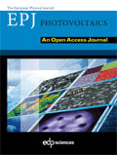
EPJ Photovoltaics
Advancing solar innovation for a sustainable future.EPJ Photovoltaics, published by EDP Sciences S.A., is a distinguished open-access journal dedicated to advancing the field of photovoltaic research and technology. Established in 2011, and operating from France, the journal serves as a vital platform for researchers, professionals, and students interested in the innovative possibilities of solar energy conversion. With a broad scope encompassing condensed matter physics, electrical and electronic engineering, and renewable energy, EPJ Photovoltaics boasts a commendable Q2 ranking in key categories as of 2023, showcasing its relevance and impact in the scientific community. Researchers will find an opportunity to disseminate their findings effectively, as the journal offers rapid publication options that align with the fast-paced evolution of the field. This publication not only contributes to academic discourse but also plays a crucial role in addressing global energy challenges, making it an essential resource for anyone invested in the future of sustainable energy technologies.

Weather
Exploring Meteorological Frontiers Since 1946Weather is a prestigious academic journal published by WILEY, specializing in the field of Atmospheric Science. Since its inception in 1946, the journal has emerged as a key resource for researchers, professionals, and students seeking to deepen their understanding of meteorological phenomena and climate dynamics. Weather is recognized for its robust impact within the scientific community, boasting a 2023 Scopus ranking of 96 out of 148 in the Earth and Planetary Sciences category, placing it comfortably within the Q2 category. Although it does not offer open access options, the journal is committed to publishing high-quality, peer-reviewed articles that advance the knowledge base of atmospheric sciences up to 2024. Through its diverse range of research, reviews, and case studies, Weather continues to play a vital role in facilitating discussions and discoveries in this essential field of study.

Solar RRL
Catalyzing discoveries in solar energy conversion and efficiency.Solar RRL, published by WILEY-V C H VERLAG GMBH in Germany, is a premier journal dedicated to advancing the field of solar energy research and technologies. With an impressive Q1 ranking across key disciplines—including Atomic and Molecular Physics, Electrical and Electronic Engineering, and Energy Engineering—this journal stands out as an authoritative source of high-impact research. Since its inception in 2017, Solar RRL has provided a platform for the dissemination of innovative ideas and findings, making vital contributions to the understanding of solar energy conversion, efficiency improvements, and sustainable technology. Researchers, professionals, and students seeking to stay at the forefront of solar energy advancements will find invaluable insights and rigorous studies in its pages. Although currently not an open-access journal, Solar RRL offers a subscription model that gives readers access to cutting-edge research that shapes the future of energy technology.

Energy Materials
Innovating Materials for a Greener Tomorrow.Energy Materials is a pioneering journal published by OAE PUBLISHING INC, dedicated to the dynamic field of energy materials science and engineering. With a focus on advancing knowledge related to materials used in various energy applications such as batteries, fuel cells, and solar cells, this open-access journal aims to disseminate cutting-edge research and innovative methodologies to a global audience. By offering a platform for original research, reviews, and case studies, Energy Materials plays a crucial role in bridging the gap between materials science and energy technology, facilitating the development of sustainable energy solutions. Researchers, professionals, and students alike will find invaluable insights in its pages, fostering advancements in this essential sector. To explore the latest developments in energy materials, visit Energy Materials at OAE PUBLISHING INC.

JOURNAL OF GEOPHYSICAL RESEARCH-SPACE PHYSICS
Illuminating the Dynamics of Our Planetary EnvironmentJOURNAL OF GEOPHYSICAL RESEARCH-SPACE PHYSICS, published by the American Geophysical Union, stands as a pivotal academic platform dedicated to the dissemination of cutting-edge research in the fields of geophysics and space physics. With an impressive impact factor and recognition as a Q1 journal in Geophysics and Q2 in Space and Planetary Science as of 2023, this journal offers an esteemed venue for researchers seeking to publish high-quality studies that advance our understanding of the interactions between the Earth and space environment. The journal features comprehensive coverage of topics spanning from the ionosphere to magnetosphere, facilitating insights critical for both academic and applied sciences. Researchers, professionals, and students will find that this journal not only presents rigorous peer-reviewed articles but also encourages the accessibility of scientific knowledge, enhancing collaboration across disciplines. With its dedicated readership and influence in the scientific community, JOURNAL OF GEOPHYSICAL RESEARCH-SPACE PHYSICS plays an essential role in fostering innovations within these dynamic fields.
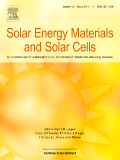
SOLAR ENERGY MATERIALS AND SOLAR CELLS
Advancing the Future of Solar TechnologiesSOLAR ENERGY MATERIALS AND SOLAR CELLS is a distinguished academic journal published by Elsevier, based in the Netherlands, focusing on innovative research in the fields of materials science and renewable energy. With a substantial history dating back to 1970, the journal has evolved into a premier platform for disseminating advanced studies related to solar energy technologies, including the development and optimization of solar cells and materials. Recognized for its high impact, the journal maintains a Q1 ranking across multiple relevant categories such as Electronic, Optical and Magnetic Materials, Renewable Energy, Sustainability and the Environment, and Surfaces, Coatings, and Films. It ranks impressively within the top tiers of Scopus, showcasing its influence and relevance in the scientific community. Although it does not offer open access, the journal remains a crucial resource for researchers, professionals, and students aiming to contribute to the advancement of sustainable energy technologies and materials innovation.